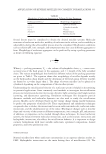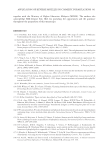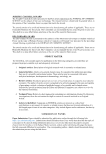337 Application of Reverse Micelles in Cosmetic Formulations folic acid, and FeSO 4 (36, 37). PC acts as a zwitterionic co-surfactant, while MO acts as a non-ionic co-surfactant. The study showed that mixed surfactant systems can promote the formation of reverse micelles. The addition of NaCl may also promote the formation of reverse micelles. All components are food grade thus are safe to include in cosmetic formulations. Another study shows the encapsulation of acrylamide in AOT and lecithin reverse micelles. Micellar growth and sphere-to-cylinder transition were observed after the addition of acrylamide (38). Reverse micelle systems have been reported to solubilize various dyes. C-phycocyanin can be solubilized in AOT reverse micelles in isooctane (39). The resulting solution has a nice blue color appearance. This shows the potential to use natural dyes in cosmetic formulations through reverse micelle systems. Examples of reverse micelle systems encapsulating active compounds or drugs are given in Table II. The formation of cylindrical reverse micelles is triggered by adjusting the compositions of the reverse micelle system. When cylindrical reverse micelles become long enough to entangle each other, organogel is formed. The formation of organogel is mainly driven by hydrogen bonding and hydrophobic forces (49). Organogel still can effectively solubilize hydrophilic compounds in nonpolar solvents, but it has different viscoelastic properties compared to spherical reverse micelle systems. Lecithin is commonly used to form cylindrical reverse micelles. Lecithin alone forms spherical reverse micelles. Certain additives can trigger the sphere-to-cylindrical transition of lecithin reverse micelle and then lecithin organogel may form. A recent study shows that addition of sugar alcohols causes the formation of cylindrical lecithin reverse micelle in n-decane (50). The viscoelastic properties of the system can be controlled by using different sugar alcohols and temperatures. Another study shows that the addition of inorganic salts such as LiCl, LiBr, LiI, NaBr, NaI, and KI leads to the formation of lecithin organogel (51). The organogel was found to form easier when using alkane solvents with longer hydrocarbon chain length. The addition of certain carboxylic acids like citric acid and 1,2,3-propanetricarboxylic acid also caused the formation of lecithin organogel (52). It depends on the number of carboxyl groups in the carboxylic acids. Lecithin organogel has been tested for encapsulation of various active compounds such as methyl nicotinate, fenretinide, curcumin (53), caffeine or caffeine TABLE II Reverse Micelle Systems and Encapsulated Active Compounds or Drugs Reverse micelle system Encapsulated compounds Reference Lecithin/IPM Insulin 40 AOT/n-heptane Igepal CO-520/cyclohexane Ascorbic acid 41 Soybean phospholipid/camelina oil Quercetin 42 Glyceryl monooleate/IPM/isopropanol Hyaluronic acid 17 Reverse micelle form by FDA compliance materials Deferoxamine 43 Polyglyceryl-3-diisostearate/vegetable oils Polar antioxidants 44 Span 80/glycolipid/olive oil Diclofenac sodium 45 Food grade lecithin reverse micelle Gallic acid, p-hydroxybenzoicacid, protocatechuic acid, and tyrosol 35 lecithin/IPM Lidocaine 46 Tween 80/Span 20/IPM/isobutanol Sodium levothyroxine 47 AOT/PC/soybean oil Ascorbic acid, folic acid, and FeSO4 36 AOT/MO/soybean oil Ascorbic acid, folic acid, and FeSO4 37 AOT reverse micelles Lecithin reverse micelles Acrylamide 38 AOT/isooctane C-phycocyanin 39 AOT/IPM Glyceryl trinitrate 48
338 JOURNAL OF COSMETIC SCIENCE microparticles (54), and Tamoxifen (55). Lecithin organogel has many advantages including ease of preparation, safety, biocompatiblity, protection of active compounds, enhanced skin permeation, and long-term storage stability. Therefore, it is a promising formulation to be included in various cosmetic products for topical applications. The SC layer of the skin acts as the first barrier that denies entrance of foreign substances and protects the inner skin layers. Sometimes it is desirable to deliver active compounds into the skin layers to repair the skin’s structure and improve the appearance. However, most active ingredients cannot normally enter the skin layers. Reverse micelles can be employed as nano-size carriers to improve the skin penetration of active ingredients into the SC layer (17). Surfactants are known to modify the skin structures. Besides that, reverse micelles can improve the hydration of the SC layers (16). These factors, combined with the small size of reverse micelles, allow the reverse micelles to penetrate skin layers while carrying their contents. Through appropriate formulation, the reverse micelles are able to release their contents at a desired spot, thus achieving targeted and sustained release of active ingredients. Delivery of active compounds through topical administration follows several routes to reach the targeted sites. These penetration routes are shown in Figure 3. The transcellular route involves direct penetration of substances though the corneocyte. The intercellular route involves penetration following gaps between the corneocyte, but not directly across the corneocyte. The trans appendageal route involves delivery via hair follicles (56). Nevertheless, penetration deep into the receptor section and systemic system of the body may not be a desirable property for skin care products. Therefore, cosmetic formulators must optimize their designs to ensure that no side effects will arise after applying the skin care products. Potential of reverse micelles as carriers for active compounds and drugs has been reported by researchers. Hyaluronic acid (HA) can be encapsulated in glyceryl monooleate reverse micelles and dispersed uniformly in IPM (17). HA is a cosmetic supplement that is used to retain the moisture and elasticity of the skin especially after UV exposure. The study shows that reverse micelles greatly enhance HA permeation in the SC, epidermis, and dermis layers. The SC penetration occurs mainly through the intercellular route. Then, the reverse micelles collapse and release HA into deeper skin layers. The reverse micelle delivery system of deferoxamine was formulated using FDA compliant materials like emulsifiers cetyl alcohol and plurol oleique (43). The formulation enhances permeation and provides sustained release of deferoxamine. The delivery performance of reverse micelle systems are affected by various factors. The addition of glycolipid can reduce the size of reverse micelles and enhance skin permeation (45). Water content and viscosity are found to affect skin permeation and the release of active compounds (40). Another study reported that skin permeation property has a complex relationship with the structure of polyethylene glycol surfactants used to form the reverse micelles (57). Integration of a reverse micelle system on other formulations can improve the delivery performance. Reverse micelle formulation with patches was reported to provide extended release of lidocaine to the skin (58). Inclusion of reverse micelle in film formulation was found to increase skin retention of sodium levothyroxine (47). Various studies showed that a reverse micelle system has the potential to be used as delivery system of hydrophilic active ingredients in cosmetic formulations. INDIRECT APPLICATIONS IN COSMETICS PRODUCTS Indirect application here refers to reverse micelle systems that are not included in final cosmetic formulations or products but are used to prepare the ingredients or to analyze
Purchased for the exclusive use of nofirst nolast (unknown) From: SCC Media Library & Resource Center (library.scconline.org)


































































































